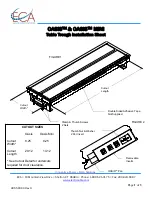
215676
437
Revision A
5.12.2
Caster Wheels
The casters wheels
’
tire pressure, wheel nut torque, and the anti-shimmy dampeners should be inspected regularly.
Inflating Caster Tire
Follow these procedures to safely inflate the tire on a caster wheel.
1000019
Figure 5.211: Safely Filling a Tire with Air
DANGER
•
Inflate the tire when the wheel is in a safety cage, if
possible.
•
Do NOT stand over the tire while inflating it. Use a clip-on
chuck and extension hose.
•
NEVER install a tube in a cracked wheel rim.
•
NEVER weld a wheel rim.
•
Do NOT exceed the maximum inflation pressure, which can
be found on the tire
’
s sidewall.
•
Ensure that all the air is removed from a tire before
attempting to remove the tire from the rim.
DANGER
•
NEVER use force on an inflated or partially inflated tire. Ensure that the tire is correctly seated before inflating it to
operating pressure.
•
Do NOT remove, install, or make repairs to a tire on a rim unless you have the proper equipment and experience to
perform the job. Take the tire and rim to a qualified tire repair shop.
•
If the tire is NOT in the correct position on the rim, or if it is overinflated, the tire bead can loosen on one side,
causing air to leak at high speed and with great force. An air leak of this nature can thrust the tire in any direction,
endangering anyone in the area.
Check the tire pressure according to the interval specified in the maintenance schedule. Caster tire pressure should be
69 kPa (10 psi).
To maintain pressure, visually check daily that tires have not lost pressure, and adjust the pressure as needed.
Underinflation of tires can cause sidewall cracks.
NOTE:
Overinflation may cause the caster wheels to shimmy.
Table 5.5 Caster Tire Options
Formed Caster
Forked Caster
7.5
–
16SL single rib,
10
–
16 front steer tire
16.5L
–
16.1 rib implement flotation,
10
–
16 front steer tire
69 kPa (10 psi)
69 kPa (10 psi)
Tightening Caster Wheel Hardware
The caster wheel hardware must be tightened in a specific pattern to prevent damage to the caster wheels.
At first use or when a wheel is removed, check the wheel nut torque every 15 minutes when the windrower is operating on
the road, or after every hour when it is operating in the field, until the specified torque is maintained across two checks.
















































